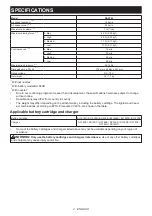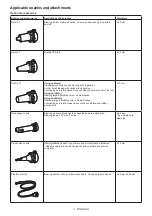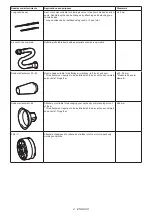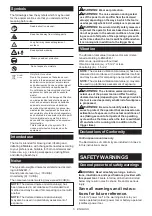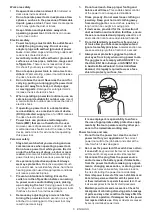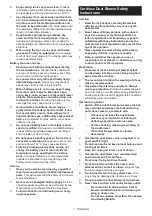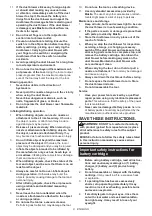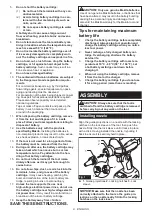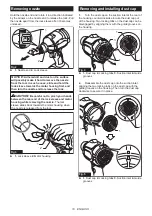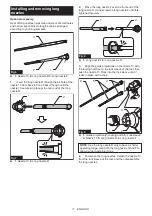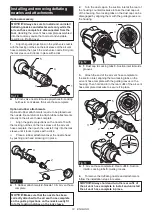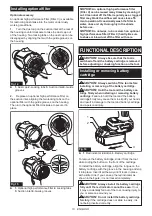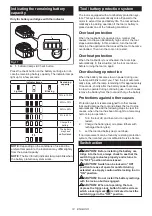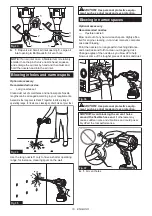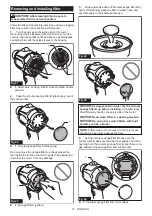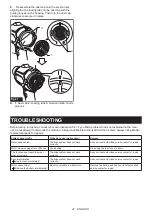
7 ENGLISH
6.
Keep cutting tools sharp and clean.
Properly
maintained cutting tools with sharp cutting edges
are less likely to bind and are easier to control.
7.
Use the power tool, accessories and tool bits
etc. in accordance with these instructions, tak-
ing into account the working conditions and
the work to be performed.
Use of the power tool
for operations different from those intended could
result in a hazardous situation.
8.
Keep handles and grasping surfaces dry,
clean and free from oil and grease.
Slippery
handles and grasping surfaces do not allow for
safe handling and control of the tool in unexpected
situations.
9.
When using the tool, do not wear cloth work
gloves which may be entangled.
The entangle-
ment of cloth work gloves in the moving parts may
result in personal injury.
Battery tool use and care
1.
Recharge only with the charger specified by
the manufacturer.
A charger that is suitable for
one type of battery pack may create a risk of fire
when used with another battery pack.
2.
Use power tools only with specifically desig
-
nated battery packs.
Use of any other battery
packs may create a risk of injury and fire.
3.
When battery pack is not in use, keep it away
from other metal objects, like paper clips,
coins, keys, nails, screws or other small metal
objects, that can make a connection from one
terminal to another.
Shorting the battery termi-
nals together may cause burns or a fire.
4.
Under abusive conditions, liquid may be
ejected from the battery; avoid contact. If con-
tact accidentally occurs, flush with water. If
liquid contacts eyes, additionally seek medical
help.
Liquid ejected from the battery may cause
irritation or burns.
5.
Do not use a battery pack or tool that is dam-
aged or modified.
Damaged or modified batteries
may exhibit unpredictable behaviour resulting in
fire, explosion or risk of injury.
6.
Do not expose a battery pack or tool to fire or
excessive temperature.
Exposure to fire or tem
-
perature above 130 °C may cause explosion.
7.
Follow all charging instructions and do not
charge the battery pack or tool outside the
temperature range specified in the instruc
-
tions.
Charging improperly or at temperatures
outside the specified range may damage the
battery and increase the risk of fire.
Service
1.
Have your power tool serviced by a qualified
repair person using only identical replacement
parts.
This will ensure that the safety of the power
tool is maintained.
2.
Never service damaged battery packs.
Service
of battery packs should only be performed by the
manufacturer or authorized service providers.
3.
Follow instruction for lubricating and chang-
ing accessories.
Cordless Dust Blower Safety
Instructions
Training
1.
Read the instructions carefully. Be familiar
with the controls and the correct use of the
dust blower.
2.
Never allow children, persons with reduced
physical, sensory or mental capabilities or
lack of experience and knowledge or people
unfamiliar with these instructions to use the
dust blower. Local regulations may restrict the
age of the operator.
3.
Never operate the dust blower while people,
especially children, or pets are nearby.
4.
Keep in mind that the operator or user is
responsible for accidents or hazards occurring
to other people or their property.
Preparation
1.
Do not wear loose clothing or jewellery that
can be drawn into the air inlet. Keep long hair
away from the air inlets.
2.
To prevent dust irritation the wearing of a face
mask is recommended.
3.
Use personal protective equipment. Always
wear eye protection.
Protective equipment such
as a dust mask, non-skid safety shoes, hard hat or
hearing protection used for appropriate conditions
will reduce personal injuries.
Operation in general
1.
Switch off the dust blower and remove the bat
-
tery cartridge and make sure that all moving
parts have come to a complete stop
•
whenever you leave the dust blower.
•
whenever you switch from inflating to
deflating operation, and vice versa.
•
before checking, cleaning or working on
the dust blower.
•
if the dust blower starts to vibrate
abnormally.
2.
Operate the dust blower only in daylight or in
good artificial light.
3.
Do not overreach and keep proper balance and
footing at all times.
4.
Keep all cooling air inlets clear of debris.
5.
Operate the dust blower in a recommended
position and on a firm surface.
6.
Do not use the tool with wet hands.
7.
Do not point the outlet of the nozzle and
attachment to yourself or others.
Objects may
be blown away and cause an injury.
8.
Do not use the tool to spray chemicals.
Your
lungs may be damaged by inhaling toxic fumes.
9.
Do not operate the dust blower at high places.
10.
Never block suction inlet and/or blower outlet.
•
Be careful not to block suction inlet or
blower outlet with dust or dirt when oper-
ating in dusty area.
•
Do not use nozzles other than the nozzles
provided by Makita.


